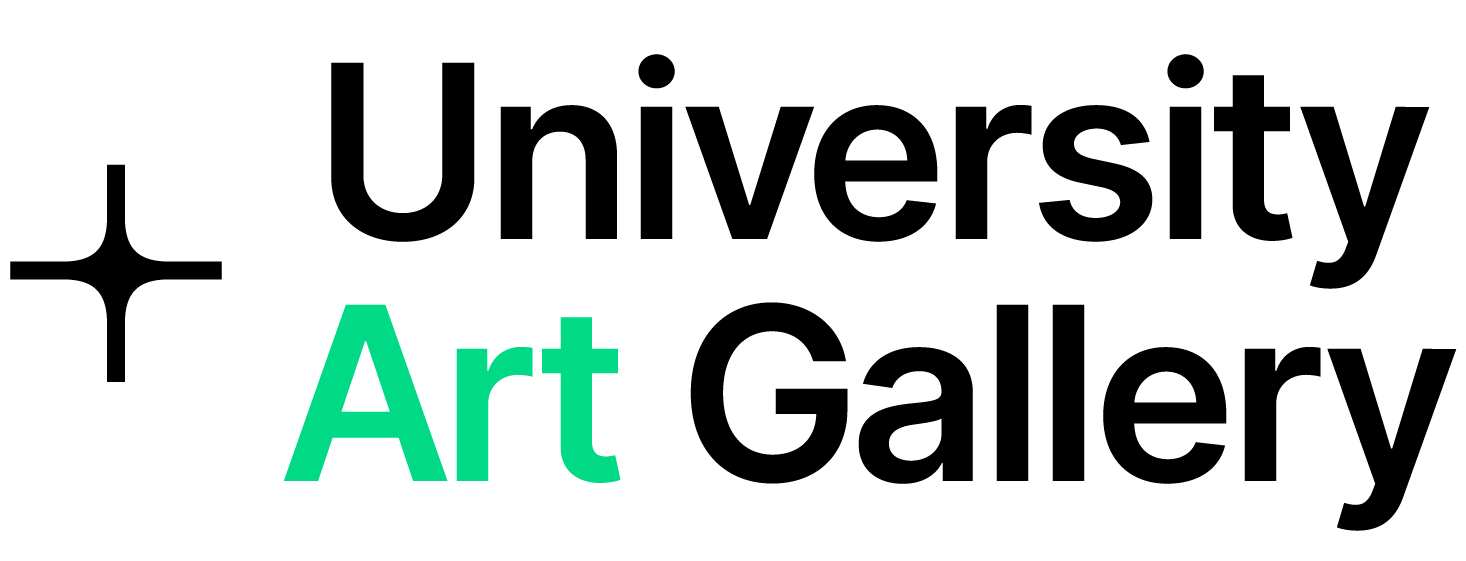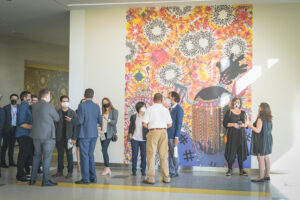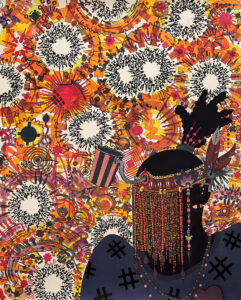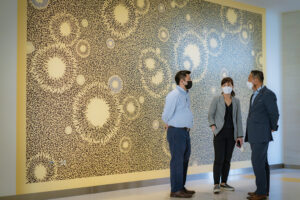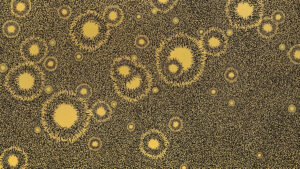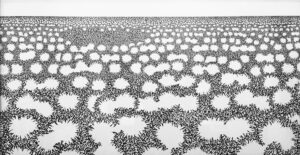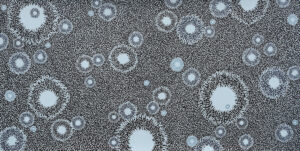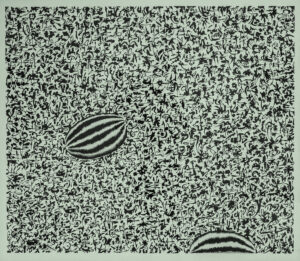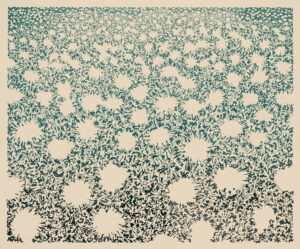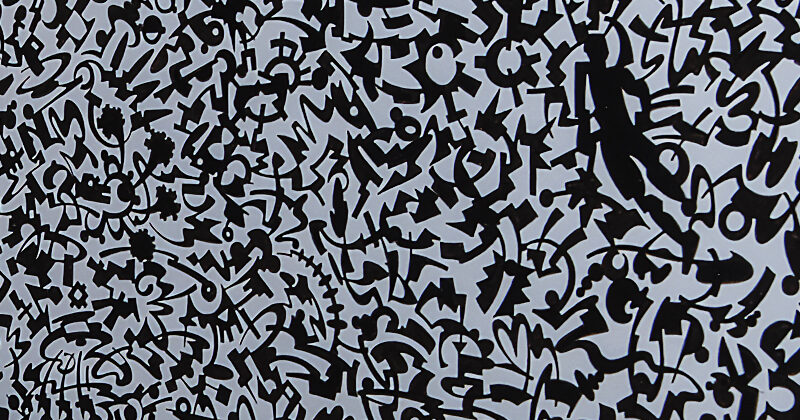
CSUDH’s Innovation and Instruction Building was completed in 2022. The mixed-use building houses the College of Business Administration and Public Policy, the Office of Graduate Studies and Research, and various learning spaces. Through a selection process that involved a community forum, Mark Steven Greenfield was chosen from a large pool of Los Angeles based artists. The committee took into consideration the artist’s professional experience, and his connection to the South Los Angeles community. Greenfield then worked with the Campus Art Advisory Committee to select eight existing artworks that were photographed at very high resolution and digitally printed as monumental-scale murals. The vinyl murals were installed on all four floors of the building. The original drawings measured between 40 x 48 inches to 40 x 71 inches.
Among the criteria for the artist’s selection process was the artist’s relationship to Los Angeles. Mark Steven Greenfield was born in Los Angeles and studied art at Otis Art Institute under artists Charles White and John Riddle. He received a Bachelor’s degree from California State University, Long Beach and a Master of Fine Art degree from California State University, Los Angeles. He has shown in art spaces, galleries, and museums domestically and internationally. Greenfield also served as the first director of the Watts Towers Arts Center and as the Director for the Los Angeles Municipal Art Gallery. Professionally, Mark Steven Greenfield’s artwork creates significant moments of interest throughout the building by using a variety of dense patterns, marks, and glyphs that spring from the subconscious mind and foster wonder and thought. The eight murals contain intricate drawings that are graphic representations of African American culture and history.
On the first floor, by the south entrance Crucilibum (2017) is the first piece on view. Originally made from an inkjet print, the drawing consists of bold colors and frantic marks which create subverted images of starburst and cotton flowers. Among these images is the presence of the Egungun depicted in cultural attire. Inspired by Greenfield’s encounter with an Egun during Yoruba ceremony he attended while in Brazil, the figure is a fusion of good and evil, positive and negative. In Yorba tradition this duality exists because the Egun can bring you good fortune and therefore many practitioners want to get close to the Egun. On the other hand, he cannot be touched because it could cause death, more spiritually rather than physically.
Hive Mantra (2017) is also located on the first floor. This series of glyphs was created by a process called automatic drawing, in which the artist expresses the subconscious through his drawing practice. In the case of Hive Mantra Greenfield used the rhythmic humming of bees that were nearby while he was reciting his mantra during meditation. The bees’ hum and the mantra began to synchronize together and created a harmony which informed the creation of the artwork. To provoke more engagement with the piece, Greenfield has hidden eleven bees among the marks.
Greenfield’s work investigates the African American experience from a historical vantage point. Located on the second floor is the mural named Zong (2019). Amidst the intricate glyphs Mark Steven Greenfield has dispersed the silhouetted images of the enslaved people from the Zong Massacre. In 1781 the captain of the British slave ship Zong had 130 captive and enslaved African people thrown overboard, due to the shortage of food and water. As was customary practice, the ship’s owners had taken out insurance for their “cargo” of enslaved people. When news of the massacre reached England, they made a claim for compensation. The insurance claim was denied. In 1783 the ensuing court case found the ship’s captain and crew negligent due to navigational errors. The massacre of enslaved people aboard the Zong, gave rise to the British abolitionist movement, but it was not until the Slavery Abolition Act of 1833 that slavery was abolished in most of the British colonies.
Crop Circle (2016) is also located on the second floor. Historically, cotton was an important crop grown on plantations in the southern states. Enslaved Black people were forced to endure the labor of picking cotton. In his depiction of these fields, a blank area amongst the cotton flowers, Greenfield provokes the viewer to question why the space is there. Was someone left there or who made this desolate island in the middle of the crops?
CC Two (2017), which is blue with black glyphs, and CC Three (2019) which is pink with black glyphs are located on the third floor. Using the automatic drawing technique, he recreates his engagement with the higher Cosmic Consciousness. Both pieces are courtesy of the Children’s Institute and the artist.
Stowaways (2011) is also located on the third floor. In this piece Greenfield combines cultural and historical references to create a piece that is deeply rooted in Black stereotypes and negative depictions of Black people. After the Antebellum period, the watermelon served as a symbol of Black citizenship and economic freedom. Contrary to these positive ideas were the xenophobic ones, which were created to preserve white cultural home rule and stop burgeoning black autonomy during the Reconstruction era. The watermelon is tied to African American history because the watermelon seeds may have arrived in the stomachs of enslaved Africans during the transatlantic slave trade.
Collard Cotton (2011) is located on the fourth floor. In this intricate field of cotton flowers, the artist has scattered images of collard leaves. Once regarded as waste and unsuitable for white people to consume, the enslaved Black people were relegated to eating these vegetables. Collard greens are considered a staple of Black cultural cuisine. Cotton has been a symbol of historical oppression as it was the main crop grown on plantations where enslaved people worked under intolerable conditions.
About the Artist
A native Angeleno, Mark Steven Greenfield studied under Charles White and John Riddle at Otis Art Institute in a program sponsored by the Golden State Life Insurance Company. He went on to receive his Bachelor’s degree in Art Education in 1973 from California State University, Long Beach. To support his ability to make his art, he held various positions as a visual display artist, a park director, a graphic design instructor and a police artist before returning to school, graduating with Master of Fine Arts degree in painting and drawing from California State University, Los Angeles in 1987.
From 1993 through 2010 he was an arts administrator for the Los Angeles Department of Cultural Affairs; first as the director of the Watts Towers Arts Center and the Towers of Simon Rodia and later as the director of the Los Angeles Municipal Art Gallery. In 1998 he served as the Head of the U.S. delegation to the World Cup Cultural Festival in Paris, France and in 2002 he was part of the Getty Visiting Scholars program. He has served on the boards of the Downtown Arts Development Association, the Korean American Museum, and The Armory Center for the Arts, and was past president of the Los Angeles Art Association/Gallery 825. He currently serves on the boards of Side Street Projects, The Harpo Foundation and Los Angeles Contemporary Exhibitions.
Greenfield’s work has been exhibited extensively throughout the United States most notably at the Museum of Contemporary Art of Georgia, the Wignall Museum of Contemporary Art, and the California African American Museum. Internationally he has exhibited in Thailand at the Chiang Mai Art Museum, in Naples, Italy at Art 1307, Villa Donato, the Gang Dong Art Center in Seoul, South Korea and the Blue Roof Museum in Chengdu, PRC. He is represented by the Ricco Maresca Gallery in New York and the William Turner Gallery in Santa Monica, California. His work deals primarily with the African American experience and in recent years has focused on the effects of stereotypes on American culture stimulating much needed and long overdue dialog on issues of race. He is a recipient of the L.A. Artcore Crystal Award (2006), Los Angeles Artist Laboratory Fellowship Grant (2011), the City of Los Angeles Individual Artist Fellowship (COLA 2012), The California Community Foundation Artist Fellowship (2012), the Instituto Sacatar Artist Residency in Salvador, Brazil (2013), the McColl Center for Art + Innovation Residency in 2016 and the Loghaven Artist Residency (2021). He was a visiting professor at the California Institute of the Arts in 2013 and was artist-in-residence at California State University, Los Angeles in 2016. He currently teaches at Los Angeles City College.
For information, please visit Mark Steven Greenfield’s site.
